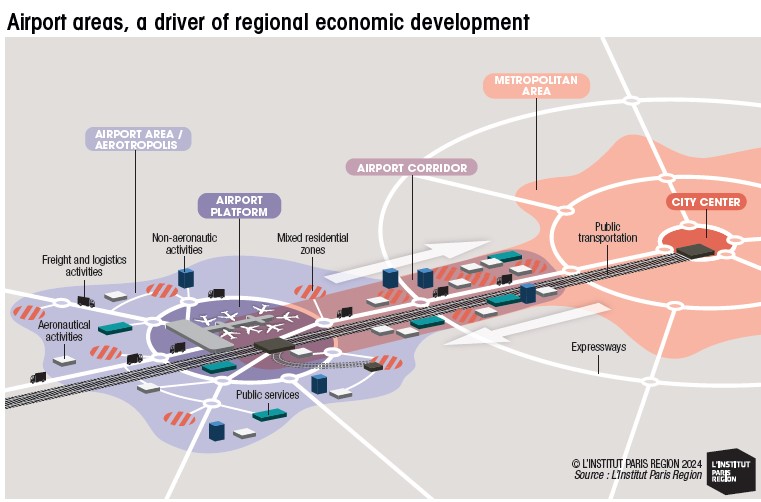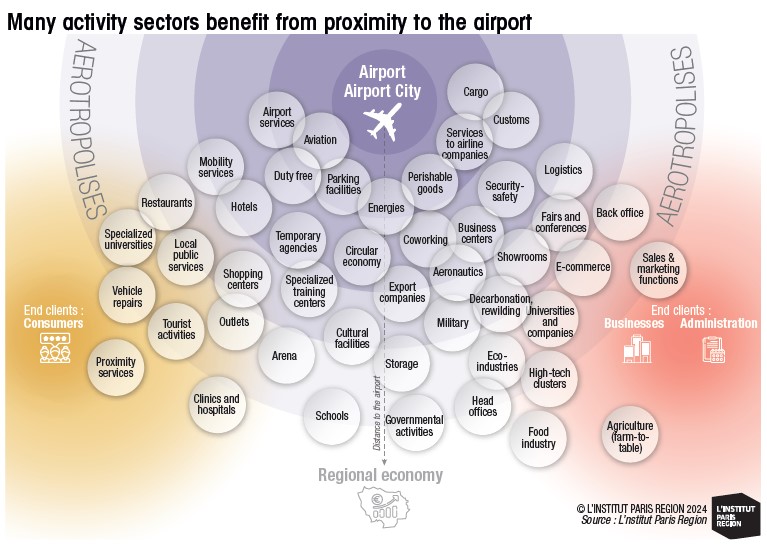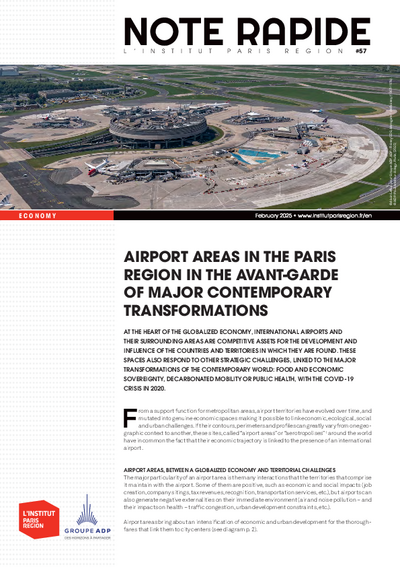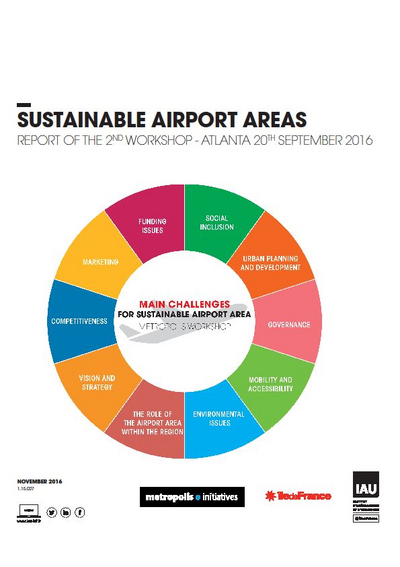Airport areas in the Paris Region in the avant-garde of major contemporary transformations
At the heart of the globalized economy, international airports and their surrounding areas are competitive assets for the development and influence of the countries and territories in which they are found. These spaces also respond to other strategic challenges, linked to the major transformations of the contemporary world: food and economic sovereignty, decarbonated mobility or public health, with the covid-19 crisis in 2020.
From a support function for metropolitan areas, airport territories have evolved over time, and mutated into genuine economic spaces making it possible to link economic, ecological, social and urban challenges. If their contours, perimeters and profiles can greatly vary from one geographic context to another, these sites, called “airport areas” or “aerotropolises”1 around the world have in common the fact that their economic trajectory is linked to the presence of an international airport.
AIRPORT AREAS, BETWEEN A GLOBALIZED ECONOMY AND TERRITORIAL CHALLENGES
The major particularity of an airport area is the many interactions that the territories that comprise it maintain with the airport. Some of them are positive, such as economic and social impacts (job creation, company sitings, tax revenues, recognition, transportation services, etc.), but airports can also generate negative externalities on their immediate environment (air and noise pollution – and their impacts on health – traffic congestion, urban development constraints, etc.). Airport areas bring about an intensification of economic and urban development for the thoroughfares that link them to city centers (see diagram below).
Lastly, the health crisis linked to Covid-19 showed the risks of a too strong dependence of the economic actors on aerotropolises in the situation of international exchanges. It drove them to look for a better balance between exterior and interior development. Since then, local actors focused on economic diversification tracks to improve these territories’ resilience in a context of changes in work (remote work, reduction in the average floor space per work station…) and the trend toward an increase in transportation methods and costs.
SPECIFIC ECONOMIC FUNCTIONS
The analysis of the characteristics of airport areas shows that they transformed themselves into metropolitan economic development drivers that, positioned as an interface with the global economy, generate thousands of jobs in “core” activities (airline companies, ground services, security, customs, maintenance, etc.). In addition, they have created employment in an ever-larger range of non-aeronautic activities (logistics, sales, industry, R&D, hospitality, leisure, administration, exhibition centers, B2B services, and so on). An activity base is often found grouped together under the acronym “AAA“ (aviation, airport, aeronautics). Economic impacts have also been observed that go far beyond the limits of the airport platform. This economic attractivity is explained by a combination of factors: an excellent level of accessibility and connectivity to the global supply chains; a capacity to facilitate business opportunities for international or export companies; a service base adapted to the needs of millions of tourists and business travelers. We can also cite a densification of economic activities that strengthen their economic polarity role and a virtuous ecosystem and dynamic that favor public investment in structuring infrastructures, which themselves generate facilities that will take form through an improvement in regional economic attractivity. If an aerotropolis has no single economic development trajectory, there are nevertheless significant possible options and depend on local situations (location of the airport area, activity rate, urbanization rate…) and its insertion in the global economy (see diagram below). As for economic activity sectors, the study of the Université Gustave-Eiffel has shown that aerotropolises rely on five major key economic activity areas: private and public activities linked to the airport infrastructure, the freight and logistics economy of the aviation sector, the aviation economy, the retail services for travelers economy and finally the knowledge economy and other production activities.
A HOST OF ECONOMIC IMPACTS
To measure the economic and social impact of the three airports in Île-de-France (Paris Region), precise data, measured scientifically, is necessary. They must be based on an uncontestable method and be on several geographic scales (from local to national). The Groupe ADP consequently commissioned, in 2023, the BDO firm to conduct a new study on the economic and social contribution of the airport platforms in Île-de-France on the national and regional economy. Completed in 2024, it concerned the year 2022. The methodology chosen by BDO was that of the Airports Council International (ACI) Europe, the one most frequently used (read box at the end of the article). In 2022, the activities of airports in Île-de-France generated the equivalent of nearly 310,000 full-time jobs and 33 billion euros of GDP in France. Most of the impacts benefit Île-de-France (70% of total jobs and 86% of the GDP). Among the 213,700 jobs created in Île-de-France, 79% came from airport activities (onsite jobs, and generated by the expenditures of onsite employees and at suppliers) and 21% by the expenditures of visitors (catalytic impacts). Direct jobs, present on the platform, amounted to 117,400 in Île-de-France, of which 89,300 at Paris- Charles de Gaulle, 25,000 at Paris-Orly and 3,100 at Paris-Le Bourget. Airport jobs are mostly permanent (92% are permanent contracts, of which 89% are full-time). There is a large share of fixed-term contracts in specific sectors, and more directly linked to the variations in passenger flows: catering, cleaning and ground-handling services. In total, women hold 40% of these jobs. Of the employees who work on the platforms, 69% live in Île-de-France and 13% in the neighboring Oise department.
PARIS-CHARLES DE GAULLE AND PARIS-LEBOURGET, THE CALL OF THE INTERNATIONAL
The airport area formed by the Paris-Charles de Gaulle international airport and the Paris-Le Bourget business airport have dynamized the economy and the territories that surround them. Located 25 kilometers north of Paris, Paris-Charles de Gaulle has become a major activity hub and an essential link in the integration of France in the global economy. Already accessible by different means of transportation (car, suburban railroad, high-speed railroad and bus) the aerotropolis will further improve, in the future, its rail accessibility, with in particular the CDG Express, line 17 of the Grand Paris Express (GPE) metro system and the TER (regional railroad) Roissy-Picardie. The Paris-Charles de Gaulle airport welcomed 67.4 million passengers in 2023. It serves 328 destinations in 119 countries, which makes it the leading airport in continental Europe. It extends over seven communes, within which an activity directly linked to the AAA sectors is concentrated. With 1.871 million tons of air freight (cargo and mail) in 2023, Paris-Charles de Gaulle is the number one cargo airport of Europe. It is moreover in this context favorable to transport and logistics activities that led to the installation of the American giant Fedex’s European hub. Its global activity has generated over 280,000 jobs in the private sector on the scale of the Grand Roissy-Le Bourget labor pool (50 communes of the Val-d’Oise, Seine-Saint-Denis and Seine-et-Marne departments). The Paris-Le Bourget business airport, the European leader, stretches over 553 hectares and concentrates more than 3,000 direct jobs. It benefits from an ideal geographic location (near the Paris Nord Villepinte exhibition center and the Pleyel sector) and land with high added-value, offering opportunities and services to business travelers. The Paris Air Show, the world leader, is held every two years here and offers an exceptional showcase to the activities present. The structuring activities of the Paris-Charles de Gaulle and Paris-Le Bourget airports platforms are concentrated around certain job-providing sectors, and, notable, airport transport (42% of direct jobs in 2023), airport services (18%), commerce and hospitality (13%) and freight-shipping-land transport (12%)2. After the Covid-19 crisis, which heavily impacted the local economy, many structural transformations are currently underway in the airport ecosystems, accentuated by the transitions to decarbonation and digitalization. They are the basis of economic diversification actions, such as energy production and a digital services offering contributing to a better travel experience. Following this logic, the Hyland’air project, local distribution of decarbonated hydrogen and bioGNV, was set up at Paris-Charles de Gaulle.
PARIS-ORLY, A EUROPEAN-SIZE AIRPORT AREA
With 32.3 million travelers in 2023, the passenger traffic of the Paris-Orly airport has returned to its pre-health crisis level. The Paris-Orly airport area (19 communes around the airport) concentrates 181,000 jobs, which makes it one of the region’s main economic hubs. Its territory of influence extends over 61 communes, and concentrates no less than 30,000 companies and a little over 425,000 jobs in the private sector3. If the airport activity holds a dominant place in the production fabric of the territory of influence, as a result of the transport-aviation sectors, airport services and logistics and freight, the commerce sector is also overrepresented in local employment, as well as in construction, to a lesser degree. Identified as a “turnkey site” in the framework of France 2030, the Grand Cœur d’Orly is an attractivity lever for tertiary and industrial campuses, for example. Likewise, the development of the Paris-Saclay scientific and technological hub played a key role in the dynamic of the territory of influence. Over the long run, the Paris-Orly airport’s territory of influence has benefited from a remarkable economic dynamic. Between 2007 and 2022, 39,500 jobs in the private sector were created, representing growth of 10.3%. In the same way as Paris-Charles de Gaulle, the health crisis was felt in a particularly intense way on the territory. It’s lower resilience capacity on the regional scale is partially explained by the very sudden halt of airport activities. Starting in 2022, the return of traffic at Paris-Orly made it possible to compensate for the effects of the health crisis and to recover the pre-Covid employment level. This growth was also fueled by several local dynamics, such as the tertiary and logistics business parks (Icade, Cœur d’Orly, Sogaris), the Rungis international market, the Villejuif health cluster and Paris-Saclay. Metro line 14 of the Grand Paris Express, which was recently extended to Orly, and the arrival of line 15 south and line 18 in the near future will create a new barycenter only 25 minutes from the capital. This increased accessibility will facilitate the innovation power of the southwest sector of Île-de-France, as well as the tourist offering of the region for passengers. A major challenge will be to ensure that the jobs created benefit as much as possible the inhabitants of the airport area. In enlarging the labor pool, these new mobilities risk accentuating the mechanism of disconnection between the local economic dynamic and the social dynamic, with more jobs accessible to non-residents.
RESILIENCE STRATEGIES THROUGH DIVERSIFICATION
Better connected to the economy of the Paris Region, notably through transport networks strengthened by the GPE, aerotropolises will continue to support the development of companies and the attractivity of Île-de-France. Located at the avant-garde of major contemporary transformations – decarbonation in the lead – these territories will also help dynamize the evolution of companies already present and take part in the development of new activities. Observing the strategies set up by the economic actors and the public administrations, the principal areas of diversification opened cover different fields. These include: hosting small and mid-size enterprises from the dense zone of the Métropole du Grand Paris, “chased” by land pressure and looking for a new site; installing production activities thanks to the facilities of aerotropolises combined with their residual land capacities; locating sales and marketing functions of French or international companies; and the development of activities connected to decarbonation ambitions. As for the fight against climate change, the Groupe ADP plays a leading role in aerotropolises (read box at the end of the article). At Paris-Orly, several initiatives warrant being underlined, like the creation of an environmental alliance and the Paris-Orly 2035 consultation, which has made it possible to treat a host of themes (mobility, renewable energies, real estate programs, etc.). At Paris-Charles de Gaulle, the Groupe ADP is also working with very involved regional administrations, such as the public interest group Roissy Meaux Aéropôle (GIP RMA), which prioritized its interventions, notably on hydrogen. Finally, the circular economy is a major issue for aerotropolises, which are involved in sustainable supply initiatives in order to create synergy and pool product-service system flows, responsible consumption, extension of the useful life of products and/or strategies to limit or better reuse waste between several economic actors. For example, the Paris-Orly airport signed an industrial ecology agreement with Semmaris. Moreover, several activities already present onsite are also a source of diversification: the security safety sector remains dynamic, linked to the state’s growing concerns related to airports, which are sensitive sites. These territories have also become demonstrators and experimentation locations for new technologies. Marked by flows of agricultural goods and food, major consumption sites, but also close to production basins, aerotropolises play a growing role in the Paris Region food system. Consequently, that of Paris-Orly relies on the Rungis international market and the Cité de la Gastronomie project. Grand Roissy Le Bourget is developing the complementary project “activity and competence hub for food, agriculture and farm-to-table,” with Semmaris (Agoralim project), as well as with local producers installed within 100 kilometers of the airport. The two airport areas in Île-de-France also have strong development potential in ongoing training to meet the needs of companies seeking a very high level of accessibility, meeting rooms and housing offerings. Lastly, sometimes considered too functional, and having few businesses and services outside the terminals, the genuine challenge of the two aerotropolises is the development of the “face-to-face” economy as a within them. The hybridization of a sales and services offering at the crossroads of the needs of travelers, inhabitants, employees and visitors is a real opportunity.
AND TOMORROW?
International airports are not solely places comprised of the flow of passengers and goods, but are now economic development levers of territories. Better served, but also disturbed by the health crisis and, especially by the large-scale transitions of the contemporary world, aerotropolises became involved in three major transformations. Their new positioning in the Île-de-France ecosystem, resulting from a very marked improvement in their regional connectivity through the GPE, will lead them to intensifying their role in the Paris Region economy. In addition, the economic diversification notably made possible by land optimization and the desires for development of economic actors and regional administrations, is encouraging the public administrations to be able to offer jobs adapted to the competencies of the neighboring populations. Finally, these territories are taking up the challenge, including in the industrial sector, of accompanying the decarbonation of airport and aeronautic activities. They are also involved in numerous initiatives on the circular economy and economic and social resilience. They thus comprise an interesting laboratory on the new multiscalar economic models that reconcile development and sobriety.■
1. In reference to the work of John Kasarda and Greg Lindsay, American scholars who popularized the role of aerotropolises in the regional economic systems, but using a very extensive approach to development levers.
2. Source: Accoss – Urssaf – PCA, 2023 data.
3. Source: Accoss – Urssaf – Ol, 2023 data.
THE FOUR ECONOMIC IMPACT CATEGORIES
Direct impacts cover jobs, revenues and the gross domestic product (GDP) generated by direct suppliers of airport goods and services. These activities are connected to the operation and management of an airport’s functioning. There are activities carried out by the airport operator, the airline companies, the air traffic controllers, etc. Indirect impacts cover the intermediate consumptions of direct suppliers, i.e., the jobs, revenues and GDP generated by the downstream activities that support and supply airport activities. They concern, for example, food and beverage wholesalers, processing companies for onboard catering, refining linked to fuel production for airplanes and firms that provide services to airline companies. The choice was made to not take the first-rank suppliers of companies present on the site into account. Induced impacts are economic activities generated on the national scale by the expenditures of the employees of companies directly or indirectly linked to the airport. Finally, catalytic impacts correspond to the socioeconomic impacts generated by the expenditures of business and leisure travelers who transited by the airport. These impacts are especially calculated on the regional and national scales.
THE GROUPE ADP, A TRANSFORMATION ACTOR
The activity of the Groupe ADP, and the airport actors as a whole, directly influences the development of the local economy and employment in the territories covered by the airport areas and their influence. That is why the three platforms – Paris-Charles de Gaulle, Paris-Orly and Paris-Le Bourget – in Île-de-France are identified over the long term as strategic economic drivers on the scale of the airport basins of Grand Roissy-Le Bourget and Grand-Orly Seine Bièvre, as well as on the departmental, regional and national scale. Consequently, the group, which has conducted, for more than 15 years, a CSR policy, formalized in its latest strategic roadmap “2025 Pioneers” a panel of objectives on the competitivity and attractivity of the territories where it is located, as well as job creation and the access of the territories’ inhabitants to jobs in the airport community. As a result, regional partnership policies are carried out to develop local purchases, with nearby small and mid-size enterprises, promote networks of support for entrepreneurship and innovation, and favor local employment. Projects directly connected to the territories’ competitivity and attractivity, such as the development and installation of new low-carbon energies (multi-energy hub, waste heat recovery, geothermal wells, methanization, photovoltaics…) on airport platforms in the Paris Region, are developed and made available to neighboring territories. Moreover, the development of multimodal hubs for all the users of active mobilities (and no longer just for air passengers), which also creates better accessibility to local jobs, equally benefits the general attractivity of the territories concerned. Lastly, the search for complementarity with industrial ecological projects that gravitate around airport platforms, and the definition of a real estate offering (service and industrial buildings, activity parks…) that complement the orientations of the territories and their needs, contribute to the development of local territorial projects. These initiatives highlight the interpenetration of the territorial and airport economic ecosystems, linked to the actions that strengthen the territorial anchoring of the Groupe ADP.
This study is linked to the following theme :
Economy





